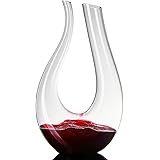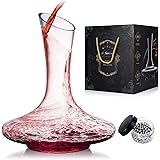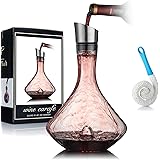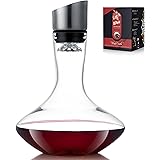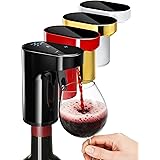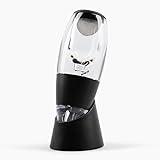Choosing the right wine glass can significantly enhance your wine-drinking experience, transforming a simple pour into a truly sensory journey. As highlighted in the accompanying video, the impact of proper glassware is far from negligible; it actively contributes to how you perceive the aroma, flavor, and overall character of your wine. Dismissing the importance of quality stemware often means missing out on the intricate nuances that winemakers strive to capture in every bottle.
Many novice wine enthusiasts initially overlook the design of their glasses, assuming any vessel will suffice. However, understanding the specific functions of different wine glass shapes is fundamental to unlocking the full potential of your favorite varietals. This guide aims to demystify the world of wine glasses, providing practical advice on building your home collection, selecting quality pieces, and ensuring their longevity through proper care.
Why Your Wine Glasses Truly Matter
The notion that a wine glass is merely a container for your beverage is a common misconception. In reality, the design of a wine glass is meticulously engineered to direct and concentrate the wine’s aromatic compounds, which are crucial for taste perception. Consequently, a well-designed glass can dramatically improve the way a wine expresses itself, allowing its unique characteristics to truly shine. Opting for quality glassware is not an extravagant expense but rather a wise investment in your culinary and sensory enjoyment.
The Sensory Connection: Smell and Taste
It is widely established that approximately 90% of what we perceive as “taste” actually comes from our sense of smell. Our olfactory receptors, located at the back of the nose, detect volatile aromatic compounds that are released from the wine. A wine glass, with its specific bowl shape and rim, is designed to capture and deliver these aromas directly to your nose. Therefore, a poor-quality glass with thick walls or an ill-suited shape can significantly diminish your ability to appreciate the wine’s complex bouquet, essentially muting its vibrant personality.
The subtle curves and varying diameters of a glass’s bowl influence how quickly alcohol evaporates and how concentrated the wine’s aromatics become. For instance, a wider bowl allows more surface area for oxygenation, encouraging the release of deeper, more intricate scents. Conversely, a narrower rim helps to funnel these delicate aromas directly upwards, ensuring that your nose receives a concentrated burst of fragrance with each swirl and sip. Ultimately, the glass acts as a sophisticated tool for enhancing your entire sensory experience, far beyond just visual appeal.
Investing in Quality Stemware
When embarking on your wine journey, the initial cost of quality glassware might seem daunting. However, it is paramount to understand that you truly get what you pay for in this category. Cheaply manufactured wine glasses often feature thick, clunky rims and lack the elegant design necessary to optimize aromatic delivery. Furthermore, such glasses frequently employ lower-grade materials that can detract from the visual clarity and overall aesthetic of your wine presentation, diminishing the experience rather than elevating it.
Conversely, investing in well-crafted stemware means acquiring glasses made from finer crystal, which boasts thinner walls and a more precise design. These premium materials contribute to a lighter feel and a clearer, more brilliant appearance, allowing the wine’s color to be fully appreciated. Beyond aesthetics, the superior design actively works to enhance the wine’s aeration and aroma concentration, thereby maximizing your tasting pleasure. Ultimately, choosing quality pieces is a commitment to a more refined and enjoyable wine lifestyle, ensuring every sip is as intended.
Finding Value in Wine Glasses
While some high-end wine glasses can indeed reach prices upwards of $100 per stem, accessible quality options are readily available for the discerning consumer. Brands like Riedel, highly favored by many wine enthusiasts, offer a range of series, with some lines surprisingly affordable at around $10 per glass. These options provide an excellent balance of quality and cost-effectiveness, making superior stemware attainable for a wider audience. Alternatively, respectable retailers like Crate & Barrel also present visually appealing and seemingly well-crafted options at an even lower price point, sometimes as little as $4 per glass.
When evaluating value, consider the durability and practical design features that contribute to a better wine experience, rather than solely focusing on the brand name. A glass with a thin rim and a bowl designed for optimal aroma collection, even if less expensive, will outperform a costly but poorly designed one. Ultimately, the goal is to find glassware that fits both your budget and your commitment to experiencing wine at its best. It’s about smart investment, not necessarily extravagant spending, to truly appreciate every drop.
Essential Wine Glasses for Your Home Collection
Building a foundational wine glass collection does not require an overwhelming array of specialized stemware. For most home enthusiasts, starting with just two essential types of glasses will adequately cover the majority of their wine-drinking needs. These core pieces are designed to be versatile enough for a wide range of varietals, yet specific enough to meaningfully enhance the characteristics of both red and white wines. Commencing with these foundational elements ensures a practical and effective starting point before delving into more specialized options.
The Versatile White Wine Glass
The standard white wine glass is an indispensable component of any home bar. Characterized by its smaller bowl and narrower opening compared to its red wine counterparts, this design serves a very specific purpose. White wines, such as Riesling, Sauvignon Blanc, Pinot Grigio, and unoaked Chardonnays, typically feature more delicate and volatile aromatic profiles. Consequently, the smaller bowl helps to contain these subtle aromas, concentrating them and ensuring they don’t dissipate too quickly. Furthermore, the reduced surface area helps maintain the wine’s cooler temperature, which is crucial for preserving the crispness and acidity inherent in many white wines, allowing for a more refreshing and accurate tasting experience.
The Robust Bordeaux (Red Wine) Glass
Equally crucial for any wine enthusiast is the standard Bordeaux glass, often simply referred to as a red wine glass or Cabernet glass. This type stands in stark contrast to the white wine glass, featuring a significantly larger bowl and a wider opening. Red wines, exemplified by Cabernet Sauvignon and Merlot, possess more robust and complex flavor profiles, requiring ample space for aeration. The expansive surface area allows the wine to breathe effectively, promoting the release of its intricate aromas and softening tannins, which results in a smoother, more expressive taste. This generous design ensures that the wine’s full spectrum of characteristics, from dark fruit notes to earthy undertones, can be fully appreciated, delivering a richer and more complete sensory experience.
Expanding Your Wine Glass Repertoire
Once you have established your core collection of white and red wine glasses, you might consider diversifying your stemware to further enhance your appreciation of specific varietals. While not strictly essential for daily enjoyment, specialized glasses can unlock an even deeper understanding of certain wines’ unique characteristics. These additional pieces cater to the nuanced requirements of particular grape types, allowing their full potential to be realized. Therefore, expanding your collection becomes a journey into refined wine appreciation, opening new avenues of sensory delight for the dedicated connoisseur.
The Elegant Pinot Noir Glass
For lovers of lighter-bodied red wines, particularly Pinot Noir, a dedicated glass is a worthy addition. This distinctive glass typically features a wide, balloon-shaped bowl that tapers significantly towards the rim, resembling a bell or a large balloon. The expansive bowl provides maximum surface area for the wine to interact with air, which is essential for Pinot Noir’s delicate yet complex aromatics to fully evolve and release. However, the narrower opening serves to concentrate these ephemeral aromas, preventing them from dissipating too quickly and ensuring they are delivered directly to the nose. This thoughtful design respects Pinot Noir’s nuanced profile, allowing its cherry, earthy, and floral notes to be truly celebrated without being overwhelmed.
Celebrating with Champagne Flutes
Champagne flutes are synonymous with celebrations and sparkling wines, universally recognized for their tall, narrow shape. This design is engineered primarily to preserve the effervescence of the wine, retaining the bubbles for as long as possible, which enhances the visual appeal and textural sensation. Consequently, the limited opening of a traditional flute is not ideal for concentrating the nuanced aromas often found in sparkling wines, such as brioche, apple, or citrus. Many sommeliers, therefore, opt for a standard white wine glass when tasting sparkling wines, prioritizing aromatic expression over bubble retention.
However, for festive occasions where visual spectacle and a sustained effervescent experience are paramount, champagne flutes remain the preferred choice. Furthermore, modern innovations in flute design sometimes include a slightly wider bowl or a specific etched point at the bottom to encourage a continuous stream of bubbles, subtly attempting to balance aroma and effervescence. Ultimately, the decision rests on the occasion and your personal preference for bubble longevity versus aromatic depth. Either way, having a few flutes on hand for toasts is always a delightful choice.
Specialized Glasses for Unique Varietals
Beyond the primary and secondary essential glasses, the world of stemware offers even more specialized options tailored to very specific wines. These glasses are meticulously designed to highlight the unique characteristics of particular varietals, accounting for their alcohol content, tannin structure, and aromatic complexity. For instance, a Zinfandel glass, often smaller than a standard red wine glass, aims to manage the higher alcohol content typical of this varietal, preventing an overwhelming alcoholic “nose.” This controlled environment helps to contain and focus Zinfandel’s rich fruit and spice aromas.
Similarly, a Syrah glass, while appearing akin to a Bordeaux glass, incorporates subtle differences in bowl curvature or rim diameter engineered to enhance Syrah’s savory and peppery notes. For oaked Chardonnay enthusiasts, a larger, broader-bowled glass, reminiscent of a Pinot Noir glass, is often preferred. This expansive design allows the complex oak, butter, and vanilla notes, characteristic of oaked Chardonnay, to unfurl and express themselves fully. These specialized designs underscore the scientific precision involved in glassware development, ensuring each wine can present its best self.
Stemmed vs. Stemless: A Matter of Preference and Function
The debate between stemmed and stemless wine glasses is largely one of preference, though functional differences exist. Stemmed glasses are traditionally favored for several reasons. Primarily, holding a stemmed glass by the stem prevents your hand from warming the wine, which is particularly crucial for white wines that are best served chilled. Additionally, the stem allows for effortless swirling of the wine, a practice that aerates the liquid and releases its volatile aromas, significantly enhancing the bouquet. From a classic aesthetic perspective, stemmed glasses also often contribute to a more elegant and formal dining experience, aligning with long-standing traditions of wine service.
Conversely, stemless glasses offer practical advantages such as increased durability and stability, as the stem is typically the most fragile part of a traditional wine glass. They are generally less prone to breaking and fit more easily into dishwashers and crowded cabinets, making them a convenient option for casual settings or outdoor entertaining. While they may not offer the same level of temperature control or aromatic enhancement as their stemmed counterparts, stemless glasses provide a modern, robust alternative for those who prioritize practicality and a relaxed approach to wine consumption. Ultimately, your choice should reflect your lifestyle and the specific occasions for which the glasses will be used.
Caring for Your Wine Glasses: Tips for Longevity and Shine
Investing in quality wine glasses naturally leads to a desire to protect them and ensure their longevity. Proper care is essential not only to prevent breakage but also to maintain their pristine clarity, which is crucial for appreciating the wine’s color and sparkle. Implementing a consistent cleaning routine will safeguard your stemware, allowing it to serve you well for many years to come. Ultimately, treating your glasses with attention and gentleness is a small effort that yields significant rewards in preserving their beauty and functionality, ensuring every pour is presented perfectly.
Hand Washing for Pristine Glassware
While many stemmed glasses are technically dishwasher safe, hand washing is often recommended for preserving their delicate nature and preventing water spots or etching, especially with hard water. When hand washing, use warm water and a small amount of mild, unscented dish soap. Crucially, always hold the glass by its bowl, never by the stem, while washing and drying; twisting the stem can easily lead to breakage, as it is the weakest point. Employ a soft sponge or cloth to gently clean the interior and exterior surfaces, paying close attention to the rim.
For particularly stubborn wine stains or to remove lingering aromas, a mixture of baking soda and vinegar can be effective, followed by a thorough rinse. Subsequently, a drying rack specifically designed for stemware can be invaluable, allowing glasses to air dry without the risk of tipping or accumulating water rings. This meticulous approach ensures your glassware remains impeccably clean and ready for its next use, perfectly showcasing any vintage.
Drying and Polishing for a Flawless Finish
Achieving a streak-free, gleaming finish on your wine glasses elevates the entire tasting experience, presenting your wine in the best possible light. After hand washing, the key to a brilliant shine lies in careful drying and polishing. Many wine enthusiasts utilize the steam from a boiled kettle to prepare glasses for polishing; the warm, moist environment helps to remove any residual water and makes the glass easier to buff to perfection. Subsequently, a high-quality, lint-free microfiber towel, ideally one specifically designed for polishing glassware, should be employed.
When polishing, again, hold the glass by the bowl, using one part of the towel to cup the bowl and the other to gently wipe and buff the glass in a circular motion. This technique minimizes pressure on the stem and ensures an even, sparkling finish, free from smudges or fingerprints. With diligent care, your wine glasses will consistently present a restaurant-quality appearance, enhancing every occasion and allowing the wine’s true character to be fully appreciated.


